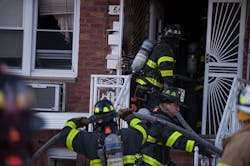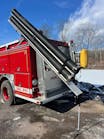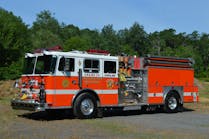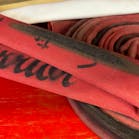The Second-Due Engine Company & the First Hoseline
The focus of every engine company is to be able to stretch and advance a hoseline efficiently and effectively. But a key factor in the hoseline stretching and advancing equation seems to be getting lost—the importance of getting the first line in place.
It seems a trend has developed in today’s fire service where the second-due engine company often rushes to pull the second line for the purpose of placing a backup line in service without first ensuring that the first line is in position and operating on the fire. One of the reasons for this is firefighters simply not understanding the roles and responsibilities of the personnel assigned to the hoseline.
Further, except for in very few fire departments in the United States, firefighters have not experienced engine company staffing levels that exceeds three to four firefighters. The problem is that these firefighters have adapted to overcome the shortcomings associated with the reduced staffing levels or, worse yet, they were never taught that there are six roles/responsibilities on the hoseline in the first place. Each of these six roles/responsibilities must be fulfilled before the second line is stretched. Apparatus staffing does not determine hoseline staffing. The necessary resources must be committed to the first hoseline to get it into position and operation, even if this requires committing multiple engine companies to the first hoseline.
Another cause for this common tactical error of rushing to stretch the second line without first ensuring that the first line is in operation is the common use of the 1¾-inch hoseline at the “bread-and-butter” fires. At these fires, even with reduced staffing, a single engine company is often able to efficiently and effectively stretch and advance the first line without assistance from the second-due engine company. This creates a false sense of ability to these firefighters who then believe that a single engine company can always stretch and advance the fire hoseline.
6 roles/responsibilities
Let’s review the six roles/responsibilities on the hoseline that must be performed:
1. Nozzle: The nozzle firefighter is responsible for the operation of the nozzle as well as the working length of the hoseline. This is the first 50 feet of hoseline behind the nozzle.
2. Officer: The officer is responsible for size-up, apparatus positioning, hoseline and nozzle selection, crew integrity and accountability, and communication.
3. Backup: The backup firefighter is responsible for assisting the nozzle firefighter. One of the main functions of the backup firefighter is to absorb much of the nozzle reaction for the nozzle firefighter.
4. Door: The door firefighter is responsible for feeding hose to the nozzle team. This firefighter should remain outside of the immediate fire area. One of the most critical functions of the door firefighter is the management of pinch points, such as turns.
5. Control: The control firefighter is responsible for estimating the hose stretch and “controlling” the number of lengths of hose that are stretched from the hosebed. This firefighter must ensure that all of the hoseline is stretched and advanced into the building and up to the fire area. Doing this ensures that no hoseline is left in the street or yard, leaving the nozzle team short of the fire area.
6. Pump operator: The pump operator is responsible for determining the proper pump pressure, supplying hoselines with water at the proper pressure for fire attack, establishing and maintaining a water supply, and monitoring pump panel gauges.
With the reduced level of staffing in today’s fire service, these six roles/responsibilities on the hoseline are sometimes combined and consolidated to match company staffing levels. A common engine company staffing level of four—and sometimes even fewer—has become the norm, and so has hoseline staffing in many instances. In that case, the breakdown of duties is as follows:
1. Nozzle: The nozzle firefighter is responsible for the operation of the nozzle as well as the working length of the hoseline. This is the first 50 feet of hoseline behind the nozzle.
2. Officer: The officer is responsible for size-up, apparatus positioning, hoseline and nozzle selection, crew integrity and accountability, and communication.
3. Backup: The backup firefighter becomes the “do it all” position. This position becomes responsible for fulfilling many of the original six roles. The backup firefighter must estimate the hose stretch and “control” the number of lengths of hose that are stretched from the hosebed, manage pinch points, feed hose to the nozzle team, and ensure that all of the hose is stretched and advanced into the building rather than left on the street or yard. After completing these tasks, the backup firefighter moves up into the normal backup position to assist the nozzle firefighter.
4. Pump operator: The pump operator is responsible for determining the proper pump pressure, supplying hoselines with water at the proper pressure for fire attack, establishing and maintaining a water supply, and monitoring pump panel gauges.
Bigger lines, same issues
As noted, the increased manageability and maneuverability of the smaller 1¾-inch hoseline has allowed engine companies to effectively stretch and advance hoselines with reduced staffing at the bread-and-butter fires. The problem is that when fires are encountered that require the larger 2½-inch hoseline, the same tactics are often attempted.
The second-due engine company must ensure that the first line is in position and in operation before stretching a backup line, especially when the 2½-inch line is in use. When the 2½-inch hoseline is used, all six hoseline roles/responsibilities should be filled. With 1¾-inch hoseline operations, firefighters may get away with pulling double duty, but this is not an option with the 2½-inch hoseline. Each role requires a dedicated firefighter. That means the second-due engine company needs to marry their personnel with the personnel of the first-due engine company in order to properly staff the first line and get the first line into position and operation.
This is also the case at many fires when the 1¾-inch hoseline is used but the incidents are more complex than the standard bread-and-butter fires. When there are many obstacles and turns in the path of the hoseline, additional staffing will often be needed to get the first line into position even though the smaller 1¾-inch hoseline is being used. This is also true when multiple floors must be ascended, specifically if there is no well hole present, as each turn of the stairwell will present another pinch point that must be managed. The solution remains the same—provide the first line with the staffing that is needed to get the line into operation before stretching a backup line.
Another common tactical error is first-due engine companies selecting a 1¾-inch hoseline when the 2½-inch hoseline is needed. This occurs due to the ease of maneuverability of the smaller hoseline. However, the flow, reach and penetration of the 1¾-inch may be ineffective. Remember, apparatus staffing does not determine hoseline selection; the hoseline determines your hoseline staffing.
In sum
There is no engine company operation that is more important than the first hoseline. As such, the first priority of the second-due engine company is to ensure that the first hoseline is in operation. If the first line is not yet in operation and in position, the second-due engine company must assist the first-due engine company in accomplishing this task. Whatever staffing is needed to get the first line into operation efficiently and effectively must be committed to the first line. Rushing to stretch the second hoseline before getting the first hoseline into operation is a tactical error that leads to increased property damage due to a less effective first hoseline but, most importantly, it does not allow the first line to do its most critical function, which is to maintain survivable spaces for victims within the building. Bottom line: Get the first line in position and in operation first. Remember the old fire service adage, “the fire goes as the first line goes.”
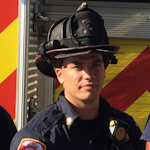
Anthony Rowett Jr.
ANTHONY ROWETT Jr. is a captain with the Mobile, AL, Fire Rescue Department. He was previously a firefighter with the Ogdensburg, NJ, Fire Department. Rowett has an associate’s degree in fire science technology from County College of Morris, NJ, a bachelor’s degree in fire science, and a master’s degree in emergency services management. He is a contributing author for multiple fire service publications and has presented at multiple fire service conferences. He has also served as a lead HOT instructor for a hoseline operations class at the Metro Atlanta Fire Fighters Conference. Rowett is the founder of Port City Fire Training. He can be reached at [email protected].
